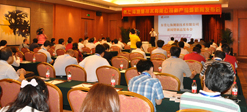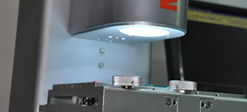Company Dynamic
Encouraging Industry and Professions to Get Smart
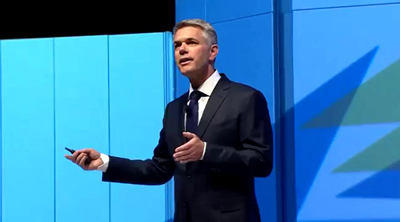
What started as a simple Q and A turned into a primer on how, in a very short amount of time, a small, flailing, Swedish company challenged conventional wisdom and grew into a global powerhouse. Familiar to our readers mainly from their Leica Geosystems business (in its ninth year as a division of the parent company), Hexagon now touches surveying, construction, CAD, GIS, mining, agriculture, metrology, manufacturing, aerospace, marine, industrial processes, government, security, power, and infrastructure—but all with common roots related to positioning, measurement, instrumentation, and data management.
Hexagon president and CEO Ola Rollén made time during the recent HxGN LIVE international conference to answer a few questions about just how he and his team have pulled this off and to share lessons we can learn from their story. He also offered a bit of tough-love advice for our professions and the industries we support. He’d like us to “work smarter.”
Q:Gavin Schrock: You’ve mentioned on several occasions that Hexagon “started by selling tuna fish.” How is it that Hexagon eventually grew into a world leader of design, measurement, and visualization solutions?
A:Ola Rollén [chuckling]: That is a long story. The principal shareholder of Hexagon brought me on board, recruited me, and started with a phrase, “I’ve wrecked this company and I don’t think you can destroy it much more, so please go ahead and do whatever you want.” I didn’t know what to do—[it was] very frustrating to know that what they were doing had no future, and I needed to find a new core business.
We then started in industrial metrology [the high-precision measurement used in industrial manufacturing and instrumentation], and we bought a U.S.-based company called Brown and Sharpe. At that time [the year 2000], Brown and Sharpe was in default, losing $40M on $280M in annual sales. It was a big catastrophe, and we managed to buy the operations, and we renamed that Hexagon Metrology.
Early on we realized that the value is not in the machine. Have you seen these coordinate measurement machines? Everyone in that industry, all of our competitors and [many of the employees at the time], believed that these [machines] were the value for our customers. We took a fresh look at this industry and we said no, the true value is in being able to tell whether [someone is] making good quality products or products that are out of tolerance. An early move was to invest in improved metrology software, and by 2005 this software had become so good that we were looking for new applications; close applications to this would be surveying, construction, and so forth.
We looked at a distribution channel for our metrology software, and then at the same time laser technology had come out—point clouds, scanning, etc.—Leica Geosystems was the leader in that. We needed [scanning] for our metrology applications, so by 2005 it was a no-brainer: we could acquire Leica Geosystems. We could find the distribution channel into surveying and construction, and we could use the point cloud technology to deploy into industrial engineering. In 2005 we acquired Leica Geosystems, creating the Geosystems division for Hexagon.
Then we realized that Leica Geosystems did not completely own all of its GPS capabilities, so that is why we acquired NovAtel, which was already a beautiful business. And now with UAVs and [everything] coming along we are able to find our own ways [to incorporate] the technologies to bring these into customer workflows.
Everything was hunky-dory and we were quite happy, but by 2008-2009, in connection to the economic crisis, [we anticipated] that … we would [eventually] see low-cost competition: competitors emerging from China, etc. We needed to find a way to stay ahead for the next 20 years. We asked ourselves, “What is it that our surveyors or other customers are doing with the data?” and of course, they put it into GIS and CAD systems.
We needed to enter into CAD and GIS to build a comprehensive workflow that could simplify things for all of the people interested in this information, and thus we acquired Intergraph. Intergraph has GIS and CAD plus imaging. With this acquisition we got Z/I Imaging; we merged that with Leica Geosystems imaging and created a great imaging business.
We started connecting the dots between Leica sensors and the geospatial software from the Intergraph SG&I [security, government, and infrastructure] division, and we connected metrology and Leica Geosystems with the Integraph PP&M [process, power, and marine] division: the CAD. Suddenly we had a lot of synergy coming out of that [Intergraph] acquisition.
What we have now is a research facility in Switzerland where we’ve combined the Leica Geosystems [specialists] with the Hexagon Metrology [specialists]. They’re not that different; it is just the accuracy that differs. The mathematical algorithms and the models are the same. For instance, the angular encoders in total stations are the same as we use in the [metrology] coordinate measurement machines.
Q:When you acquired Leica Geosystems, you had not dealt with surveyors and surveying before. Was there something that was of particular benefit—something you learned from Leica Geosystems and their roots in surveying?
A:What we learned from Leica Geosystems was how to develop. They’re a fantastic development machine, and at their facility in Switzerland the R&D is beautiful. The consistency and the loyalty to engineering tradition are fantastic. The metrology development has been moved there. It has been great to learn just how to approach a technical problem and how to lay out a project to create a project.
It has been nine years since we’ve acquired Leica Geosystems, and we can definitely say that we’ve both benefitted from becoming a team. We were able to bring some experience in software from Hexagon Metrology to Leica Geosystems as well. [Editor’s note: The Leica Geosystems facility in Heerbrugg, Switzerland is profiled in “The Pre in Precision,” in the December 2013 issue of Professional Surveyor magazine.]
Q:Another recent acquisition is Veripos and the PPP (precise point positioning) solutions they’ve developed for maritime industries. What does Hexagon have in mind for Veripos?
A:It will be a business servicing Hexagon Geosystems, NovAtel, and Integraph SG&I. It will provide corrections, if you might call it that, based on their TerraStar solutions. [They developed this for maritime industries and navigation]. But in the near future, Leica will start a service where surveyors can subscribe to correction services [to use this on land].
Q:What are the next big steps?
A:The next big step is what we are doing currently, which you have seen throughout this [HxGN LIVE] conference, and that is to verticalize [adapt to vertical markets]. For example, instead of selling a total station to 40 to 50 different [lines of business] or industries, we want to have one total station for mining, one for agriculture, one for construction, etc. It has to be much more dedicated towards the customer base it is supposed to serve.
We are very much interested in a successful future of surveying. We can develop symbiosis; Leica Geosystems needs to continue in the new direction. Going back to what I said before, we need to represent more than just our instruments and measurements. So it is very much in our interest for surveyors and other customers to be successful.
For example, we have launched content as a service. If someone buys an MS50 and surveys this whole building, and if it is available through the service worldwide, someone might find a need and you can get paid for it. You could use iTunes as an analogy. You become a provider of such data [measure once and use many times]. There are a lot of possibilities; we are very serious about this.
A:The word “smart” is featured a lot by Hexagon, even in product names. You’ve said in several keynote addresses that we all need to work smarter. Do you have any tough-love advice for the types of professions and industries Hexagon serves? Is there something they are doing wrong or should be doing better?
Q:I think it’s about definition. For instance, when we entered into metrology we took a completely new approach. It was not just about making “the most beautiful machine in the world,” it was about finding what is wrong with your manufacturing process and correcting it. We have taken exactly the same approach with [other divisions] of Hexagon. [For instance,] it is not about being a surveyor measuring and collecting data, it’s about providing something for somebody else, and that somebody else has a job to do with your data. So, you need to find out what happens to this information in the next step, and the following steps.
What we are really interested in and what we are currently working on is to understand [for example] construction from the day the construction company gets the order until they deliver the finished product. It could be a bridge, or building, etc., and [we want to understand] how our products and industry are affecting that process, and how we can improve that and help the construction company [and downstream clients] save time and money.
I am certain that a lot of industry falls into the trap of, “I’m going to build the best thing,” without considering what is done with it. Look at the automotive industry: they run the risk of being overrun in some ways by companies like Google and Apple. They are going to end up producing a simple piece of metal if they don’t watch out—all of the intelligence is going to be owned by these IT companies. I mean, why would a car company own the dashboard? Why couldn’t you just slide in some tablet for all of the intelligence: the navigation, music, automation, crash avoidance and so on? With those being of such high value, then how much do you want to pay for that piece of metal that is left?
You see that in all sorts of industries: the players in the industry have not really fully understood why the customers are buying their products. It may just be that they are buying because it is the best alternative they could find and maybe it is not optimum for what they want to do or achieve. I think you need to be really receptive to these signals and history is full of companies that have not been receptive, and they have run out of business.
Q:Earlier at a press event at HxGN, you said there will be self-driving cars in 40 years. The technology seems to be here already, so why 40 years?
A:People will laugh in 40 years that we had to drive our own cars. I do not think it would be bad to push autopilot on a long trip and go in the back seat for a while to relax. Mercedes has promised an autonomous car by 2017. Yes, the technology is here, but the restriction is law: the legal implications. Who is liable when two autonomous cars collide? You have insurance issues, legal implications—that will be the red tape and the legacy of old cars. We get stuck in our own red tape and old ideas. Like with UAVs, let’s embrace it.
Q:If we work smarter and realize these engineering efficiencies, does this provide benefit in the form of things that do not usually show up on a balance sheet, like the environment and certain societal benefits that some might consider intangible?
The instrument is the enabler. If you go into business you can decide to care about other things than money, or you can decide not to care about something; that is the beautiful spin on what we are doing. We are actually helping the environment as well. Are we tree huggers? I would not call us that, but we care about the environment.
Q:Along the lines of what people call “light green”—low impact or symbolic efforts—in contrast to “dark green” or substantive and impactful efforts.
A:Yes, if we improve efficiency, we are helping. Take the example of turbine engines. In our keynote [at HxGN Live], the gentleman spoke of building 30,000 new airliners by 2030. With the new technology we’re developing we can enable the manufacturers to install these new turbines that will reduce fuel usage by up to 40%. This comes though improvements in things like the metrology [producing those turbine blades to within 0.1mm]. If you can reduce the fuel consumption by 35% or more we will be using less fuel [in 2030] with 50% more airliners.
That is my point in these keynotes: don’t go light green—no one wants to live in a cave. That is not the solution to the pollution, going back in time. Instead we need to use these applications to reduce emissions, to do things smarter. There are all sorts of possibilities through modern technology to actually fix Mother Earth, and why not do that?



 Corporate Awards
Corporate Awards Enterprise Culture
Enterprise Culture Demo Centre
Demo Centre Promotional Video
Promotional Video Talent Strategy
Talent Strategy Company Profile
Company Profile Contact Us
Contact Us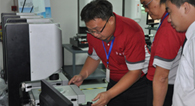
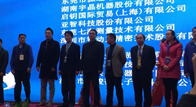




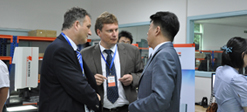

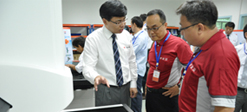
 Shenzhen
Shenzhen Korea
Korea Taiwan
Taiwan Nanjing
Nanjing Shanghai
Shanghai Suzhou
Suzhou Chengdu
Chengdu